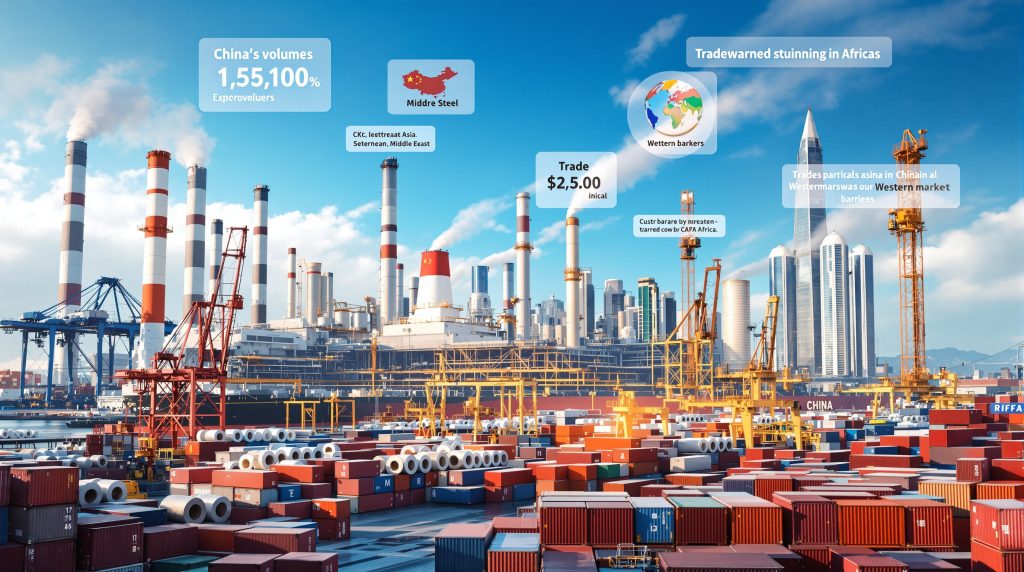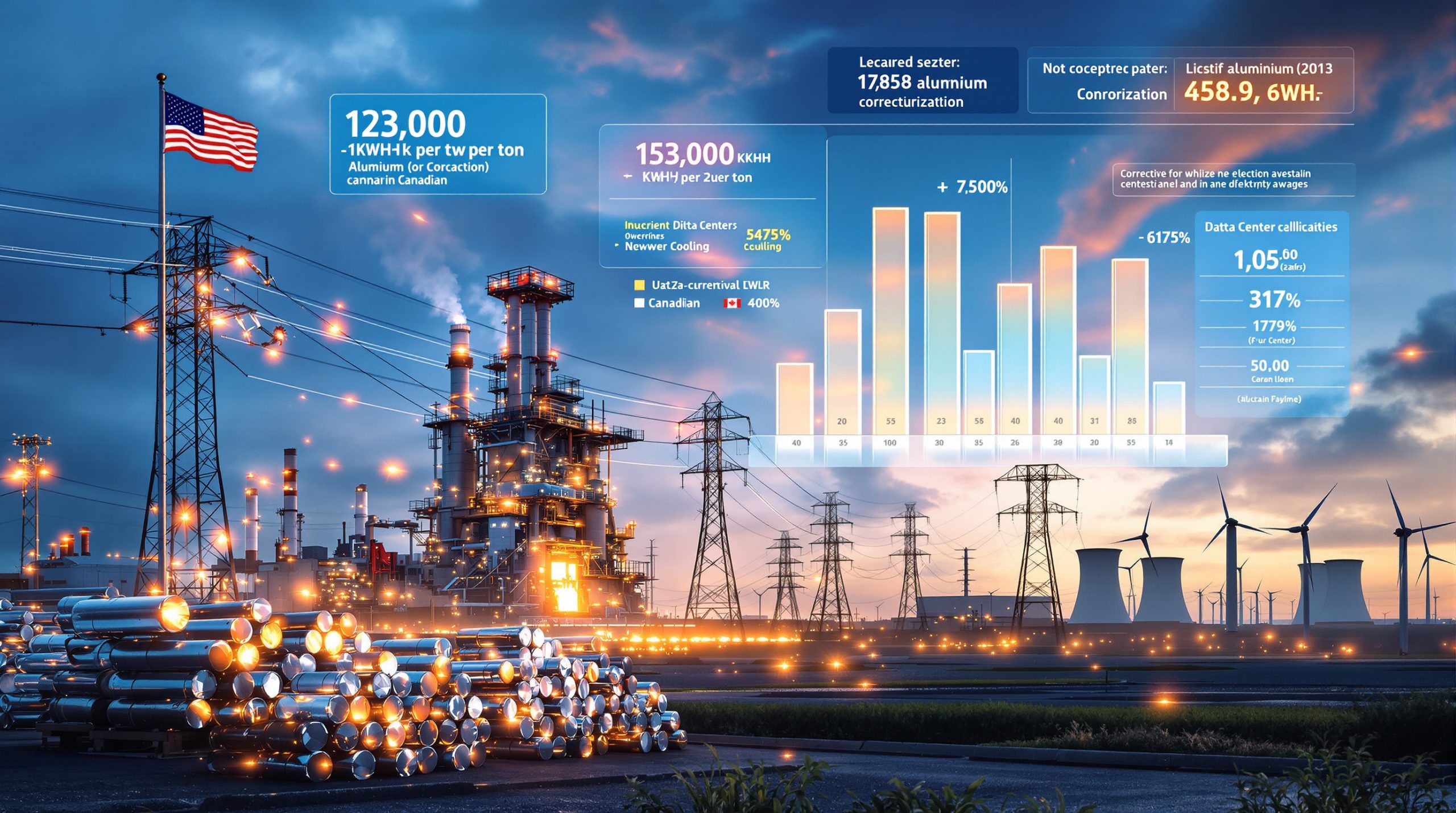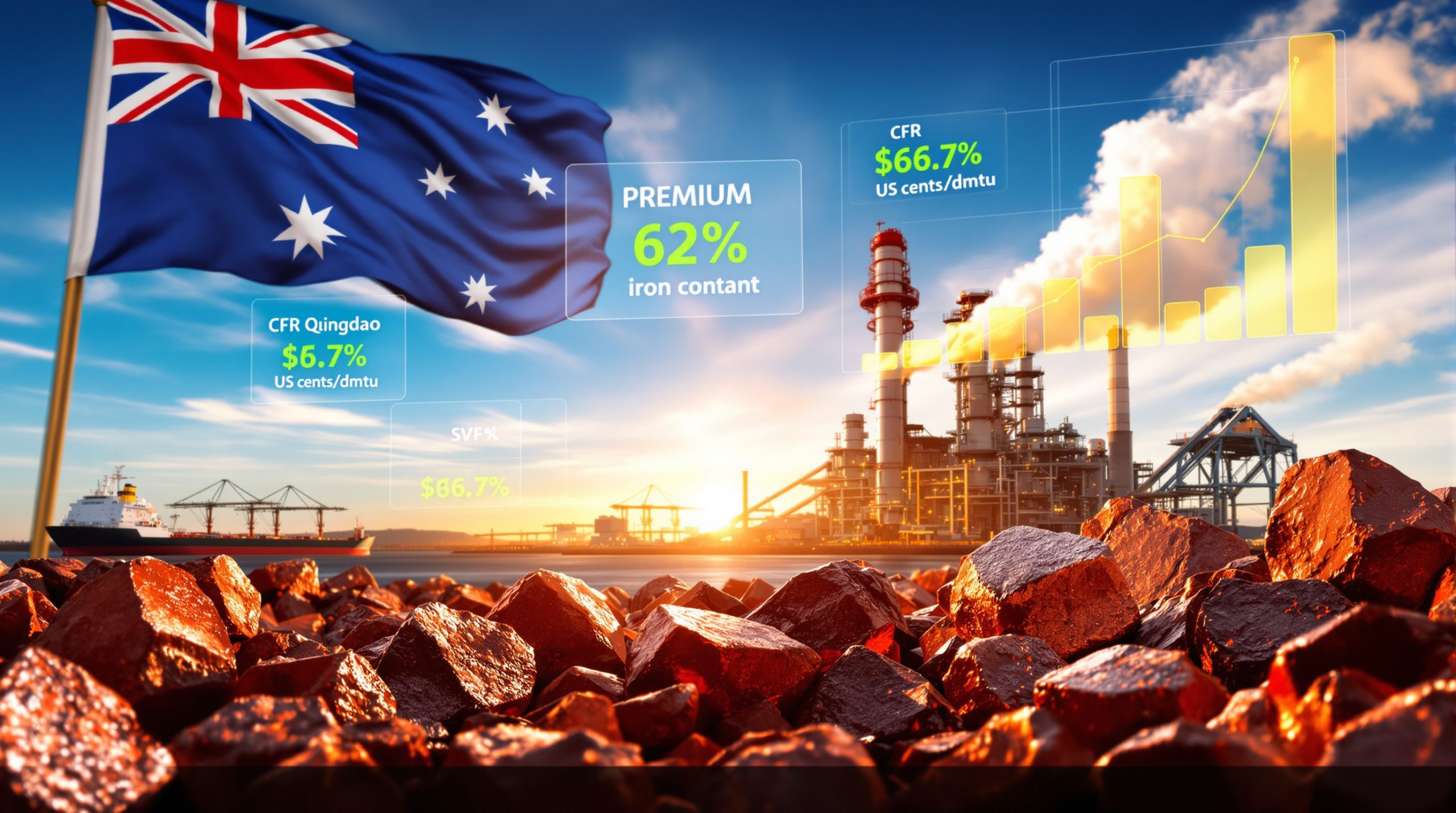China's Steel Export Outlook: Navigating Global Markets Through 2025 and Beyond
China's steel export sector has demonstrated remarkable resilience in 2025, maintaining volumes above 100 million metric tons despite growing international trade barriers. According to Reuters reporting via Kitco News, the first seven months of 2025 saw exports climb by 11.4% to reach historic highs. This growth persists even as major steel-consuming nations implement protective measures against Chinese steel imports.
Current Export Volume Trends
Record-breaking export performance has defined early 2025, with monthly volumes consistently increasing through mid-year. While this momentum remains strong, industry experts anticipate a cooling in Q4 2025 due to seasonal factors and increasing trade pressures.
Baosteel, China's largest listed steelmaker, has exported 4.83 million tons in the first seven months of 2025, compared to 6.07 million tons for all of 2024 – showcasing the accelerated pace of exports. According to Reuters reporting, Baosteel Chairman Jixin Zou indicated that steel exports will likely fall in Q4 2025 from current high levels, constrained by potentially higher export prices, new tax regulations, and tariffs' market effects.
Key Export Markets in 2025
While China continues to push steel products globally, export destinations have evolved in response to trade barriers. Traditional markets in developed economies have been supplemented by growing demand from emerging economies seeking infrastructure development materials.
Southeast Asian nations remain primary destinations for Chinese steel, with Vietnam and the Philippines showing particularly strong demand despite some regional trade tensions. The Middle East continues to absorb significant volumes, while African markets represent growing opportunities.
What Factors Are Driving China's Steel Export Growth?
Domestic Market Challenges
The robust export performance comes amid significant domestic market challenges that have pushed Chinese steelmakers to look abroad for sales opportunities. Baosteel has explicitly cited soft domestic demand affecting the market in its communications with investors and analysts.
China's property sector continues to struggle with low confidence and high inventory levels, directly impacting steel consumption in construction. The manufacturing sector, another major steel consumer, has shown inconsistent growth patterns, further limiting domestic demand potential.
These factors have created intense price competition in the domestic market, pushing steelmakers to seek more profitable opportunities in international markets despite thinner margins and trade barriers.
Strategic Product Shifts
Chinese steel exporters have demonstrated remarkable adaptability by shifting their product mix to navigate trade barriers. Semi-finished steel products have seen particularly strong growth as they often face fewer restrictions than finished products.
The industry has increasingly focused on higher-value specialty steel products that can command premium prices in international markets. By developing steel grades that meet stringent international environmental standards, Chinese producers have maintained access to markets with tightening regulations.
What Trade Barriers Is Chinese Steel Facing?
The global response to China's steel export surge has intensified throughout 2025. Despite these challenges, Chinese exports have continued to grow, as noted by Reuters reporting that exports hit record highs "despite trade barriers being thrown up."
Growing International Restrictions
Under the Trump administration, which returned to office in January 2025, the United States has maintained significant tariffs on Chinese steel products. The administration has signaled potential increases to these measures as part of its broader tariff‐driven trade shifts.
The European Union has implemented carbon border adjustment mechanisms that particularly affect carbon-intensive imports like steel. These mechanisms effectively function as tariffs on products from countries with less stringent environmental regulations.
Asian nations that previously served as major destinations for Chinese steel have increasingly launched their own protective measures, concerned about impacts on domestic producers.
Regulatory Responses
Importing countries have implemented stricter customs declaration processes and enhanced traceability requirements for steel origin certification. These measures aim to prevent circumvention of tariffs through transshipment or minimal processing in third countries.
Regional trade blocs have increasingly coordinated their protective measures to prevent importers from exploiting regulatory differences between neighboring countries.
How Are Chinese Steelmakers Responding to Export Challenges?
Baosteel's Export Strategy
As China's largest listed steelmaker, Baosteel's approach provides insights into the broader industry strategy. Reuters reporting confirms that Baosteel currently has the capability to export 10 million tons annually.
The company has publicly announced ambitious targets to reach export capacity of 15 million tons by 2026 and 20 million tons by 2028, according to statements from Baosteel general manager Baojun Liu. This strategic prioritization of exports demonstrates the company's response to domestic market challenges.
Baosteel has focused on higher-value steel products that can command premium prices and face fewer trade restrictions. Their portfolio increasingly includes specialized steel grades for renewable energy infrastructure and automotive applications, which command higher margins.
Industry-Wide Adaptation
The broader Chinese steel industry has responded to export challenges by increasing investments in production efficiency. This allows producers to maintain competitiveness despite compressed margins and rising energy costs.
As international standards evolve, Chinese producers have accelerated development of green production efforts. This strategy aims to future-proof exports against increasingly stringent carbon border adjustment mechanisms.
Strategic partnerships with overseas distributors have helped secure market access despite formal trade barriers. These relationships allow Chinese producers to better understand local market needs and regulatory requirements.
What Is China's Approach to Steel Overcapacity?
"Anti-Involution" Policies
China's leadership has signaled a significant shift in approach to the steel industry's structural challenges. Reuters reporting confirms that China's top leadership pledged in July 2025 to crack down on a deflationary price war, which sent prices higher.
The term "anti-involution" has entered the policy lexicon, referring to efforts to prevent destructive competition that creates oversupply without improving productivity or innovation. Baosteel has publicly stated it would closely monitor these "anti-involution" policies and measures to cut steel output.
Reuters reporting indicates that China will push to cut steel output between 2025 and 2026 as it tackles overcapacity issues. This represents a more assertive approach to supply-side reform than previously implemented.
Production Control Measures
The planned implementation of production cuts between 2025-2026 marks a concrete step toward addressing long-standing overcapacity issues. While specific numbers haven't been officially confirmed, industry analysts anticipate meaningful reductions that could help stabilize both domestic and international markets.
Environmental compliance inspections have increasingly affected production capabilities across the industry. These inspections serve the dual purpose of addressing pollution concerns while indirectly managing capacity.
Energy consumption limitations, implemented as part of China's carbon reduction goals, have further impacted steel output. These measures disproportionately affect less efficient producers, potentially accelerating industry consolidation.
What Is the Outlook for China's Steel Exports in 2026 and Beyond?
Short-Term Forecast (2025-2026)
Export volumes are expected to remain above 100 million tons through 2025, according to Baosteel's public statements reported by Reuters. However, the company has indicated that exports will likely fall in Q4 2025 from current high levels.
Several factors could contribute to this moderation, including higher export prices, new tax regulations, and intensifying tariff barriers. The gradual implementation of production cuts will likely begin to affect export availability by late 2026.
As trade tensions persist, Chinese exporters will continue shifting toward higher-value and semi-finished products that face fewer restrictions. This product mix evolution represents a strategic adaptation to the changing trade landscape.
Medium-Term Projections (2026-2028)
Strategic capacity reduction is expected to gradually balance supply with demand, potentially stabilizing global steel prices. This could benefit Chinese producers by reducing price volatility and improving margins.
Baosteel's targets for export capacity of 15 million tons in 2026 and 20 million tons in 2028 indicate a continued strategic focus on international markets despite domestic production constraints.
Growing emphasis on product quality over quantity will likely characterize China's steel export outlook. This approach aligns with both domestic policy goals and the realities of international trade restrictions.
Long-Term Considerations
The technological transformation of China's steel industry toward greener production represents both a challenge and opportunity. Significant investments will be required, but success could position Chinese producers advantageously as global markets increasingly prioritize sustainability.
China may gradually reposition itself as a supplier of premium steel products rather than commodity steel. This transformation would mirror the evolution seen in other industrial sectors where Chinese manufacturers have moved up the value chain.
Adaptation to evolving carbon border adjustment mechanisms worldwide will be crucial for maintaining market access. Early investment in emissions reduction technology could provide a competitive advantage as these mechanisms expand globally.
How Are Global Markets Responding to Chinese Steel Exports?
Price Impacts
Chinese steel exports have exerted downward pressure on global steel prices throughout early 2025. This pressure has been particularly pronounced in markets with high exposure to Chinese imports.
Reuters reporting confirms that steel prices increased following China's July announcement on overcapacity measures. This market reaction demonstrates the significant influence Chinese policy decisions have on global steel markets.
Regional price variations have emerged based on exposure to Chinese imports and local protective measures. Markets with stronger trade barriers have maintained higher price levels, while more open markets have experienced greater price pressure.
Competitive Responses
Steelmakers in developed markets have increasingly focused on specialty products that face less direct competition from Chinese imports. This specialization strategy aims to preserve margins while conceding some commodity segments.
Cost-cutting initiatives have accelerated across global steel producers as they attempt to remain competitive with Chinese imports. These efforts include both operational efficiency improvements and, in some cases, labor cost reductions.
Industry consolidation has accelerated in regions most affected by Chinese exports. Mergers and acquisitions allow producers to achieve economies of scale and improve bargaining power with both suppliers and customers.
What Challenges and Opportunities Lie Ahead for China's Steel Export Sector?
Key Challenges
Intensifying trade barriers and protectionist measures worldwide represent the most immediate challenge for Chinese steel exporters. These barriers are unlikely to diminish in the near term, particularly following political shifts in major importing nations.
Thin profit margins limit investment capacity at precisely the time when significant capital expenditure is needed for technological transformation. This financial constraint could slow adaptation to changing market requirements.
Environmental compliance costs affect price competitiveness in a market where margins are already compressed. These costs will likely increase as China implements its own climate commitments.
Geopolitical tensions potentially disrupt established trade relationships, creating uncertainty for exporters. Recent shifts in U.S. trade policy under the Trump administration exemplify this challenge, with US tariff impact on iron ore creating ripple effects throughout metal markets.
Strategic Opportunities
Growing demand from developing nations' infrastructure projects creates natural markets for Chinese steel. These markets often have fewer trade restrictions and align well with China's broader economic diplomacy initiatives.
China could potentially establish leadership in green steel production technologies through early and substantial investments. Success in this area would position Chinese producers advantageously as global standards evolve.
Value-added processing can create higher-margin export products that face fewer trade restrictions. This approach aligns with China's broader economic strategy of moving up the value chain in manufacturing sectors.
FAQ: China's Steel Export Market
Will China implement export taxes on steel products?
While China has periodically adjusted export tax rebates for steel products, comprehensive export taxes remain unlikely in the near term. Such taxes would conflict with maintaining employment in the steel sector, a key economic and social priority.
However, targeted adjustments to discourage exports of energy-intensive, low-value steel products remain possible. These adjustments would align with both environmental goals and the strategic shift toward higher-value products.
How are Chinese steelmakers maintaining profitability despite trade barriers?
Chinese steelmakers are focusing on operational efficiency, product diversification, and strategic market selection. By pivoting toward higher-value products and markets with fewer restrictions, they've maintained export volumes despite compressed margins.
Baosteel's reported 7.4% annual increase in first-half net profit despite soft domestic demand and lower steel prices demonstrates the effectiveness of these strategies. This performance indicates that leading Chinese producers have successfully adapted to challenging market conditions.
What impact will China's overcapacity reduction have on global steel prices?
If implemented effectively, China's planned production cuts could gradually stabilize global steel prices. The market reaction to the July 2025 announcement, which sent prices higher, provides an early indication of this potential impact.
However, the ultimate effect will depend on the pace and scale of capacity reduction, as well as global demand trends. If demand weakens significantly, even substantial capacity reductions might not prevent price pressure.
How are Chinese steel exports affecting global decarbonization efforts?
The carbon intensity of Chinese steel production remains higher than in some developed markets, creating tension with global climate goals. This discrepancy has provided justification for carbon border adjustment mechanisms in some importing regions.
However, Chinese producers are increasingly investing in greener production technologies to maintain market access as carbon border adjustments expand. This transformation could eventually align China's steel exports with global decarbonization objectives.
Chinese steel exporters face a complex landscape of challenges and opportunities as they navigate global markets through 2025 and beyond. While trade barriers, overcapacity issues, and environmental requirements present significant hurdles, strategic adaptations in product mix, market selection, and production technology offer pathways to continued success. Additionally, close monitoring of iron ore trends remains essential for steelmakers seeking to optimize their cost structures in an increasingly competitive global market.
Want to Spot the Next Major Mining Discovery?
Discovery Alert's proprietary Discovery IQ model delivers instant notifications on significant ASX mineral discoveries, empowering investors to identify actionable opportunities before the broader market. Visit our discoveries page to understand how major mineral discoveries have historically generated substantial returns for early investors.




